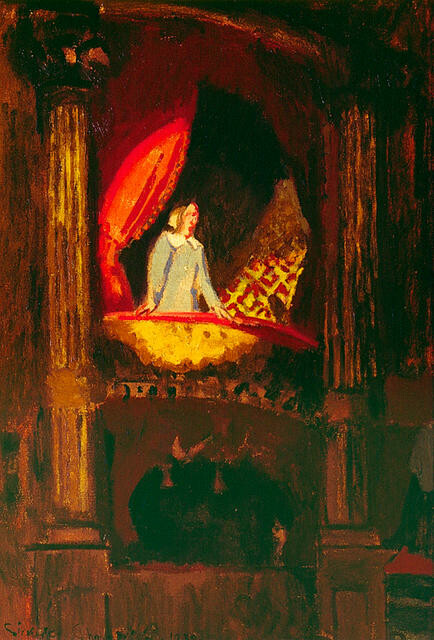Walter Richard Sickert
British, b.1860, d.1942
The Shoreditch Empire
- 1920
- Oil on canvas
- Bequeathed to the New Zealand Government by Mr Odo Cross and presented to the Gallery, 1965
- 950 x 730mm
- 69/366
- View on google maps
Tags: actors (performing artists), artificial lighting, columns (architectural elements), costume (mode of fashion), performing artists, spotlights, stages (performance spaces), theaters (buildings)
Music halls had their hey-day before World War I but there were still two Shoreditch music halls in London in 1920 - the ‘London’ (also known as the ‘Empire’) and the ‘Olympia’. Walter Sickert did many drawings and some paintings in both of them. As with the brilliantly lit, lone figure here, the theatres allowed him to explore the effects of artificial light set against the darkness of the stage. An important and original British artist, Sickert was influenced by James McNeill Whistler (1834 -1903) and Edgar Degas (1834 -1917). Sickert was born in Munich, the son of Danish artist Oswald Aldabert Sickert (1828 -1885) with whom he came to England in 1868. He studied at the Slade, becoming a pupil of Whistler, and travelled to Paris where he met Impressionist painters, including Degas. Sickert became a member of the Royal Academy in 1934 but he also exhibited with a number of more avant-garde groups, including the New English Art Club, the Fitzroy Street Group and the Camden Town Group.
Exhibition History
The painter of this work was perhaps the most important and original British artist of his time. A pupil of James McNeill Whistler and a friend and follower of Edgar Degas. His work and teaching was an inspiration to successive generations of British artists who sought to escape from the established academic style.
Sickert’s subject interest varied through his long life as an artist ranging from landscapes of Dieppe and Venice, figurative scenes portraying the inhabitants of lodgings in Edwardian Cambden Town to the evocative imagery of music halls and theatres of London and Paris. By 1920, Sickert was living in France but at the beginning of that year he spent a few months in London making drawings and paintings of the Shoreditch music halls, in particular the London (also known as the Empire) and the Olympic. The age of the music hall which had its hey-day prior to World War One was all but over and many of the theatres faced closure, demolition or conversion to cinemas.
The influence of Sickert’s mentor Degas can be discerned in the conception and composition of this painting of the former Empire music hall. Especially in its verticality and slightly schematic lighting effects that cast a strong spotlight on the standing figure in the box. In September 1917 Edgar Degas died and it has been considered that Sickert’s theatre painting of the 1920s were in a sense done in homage.

